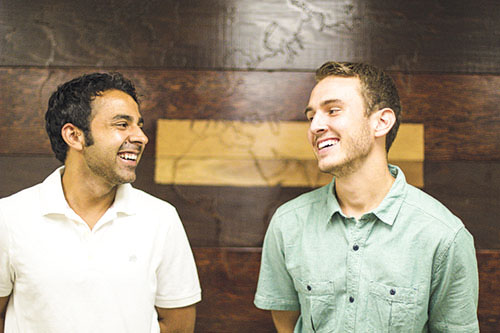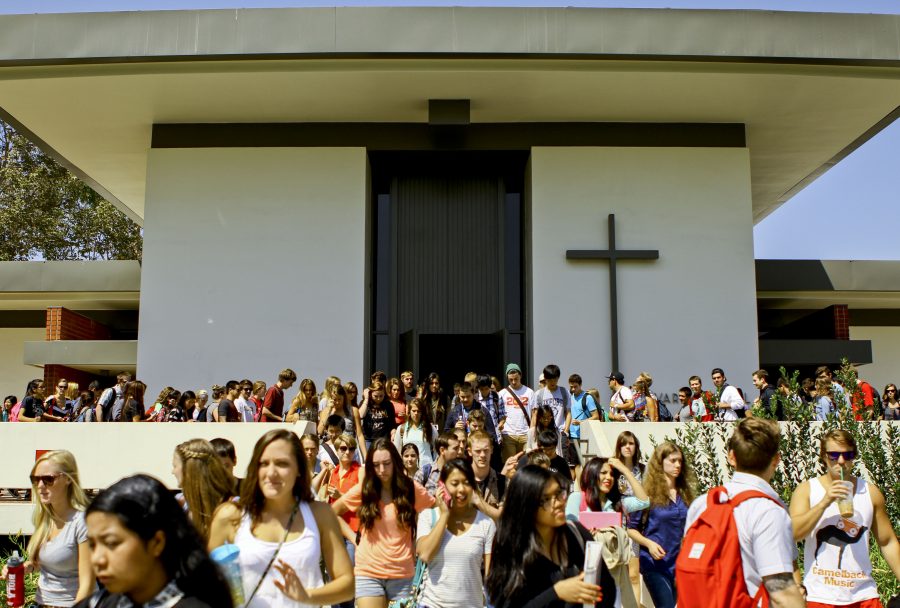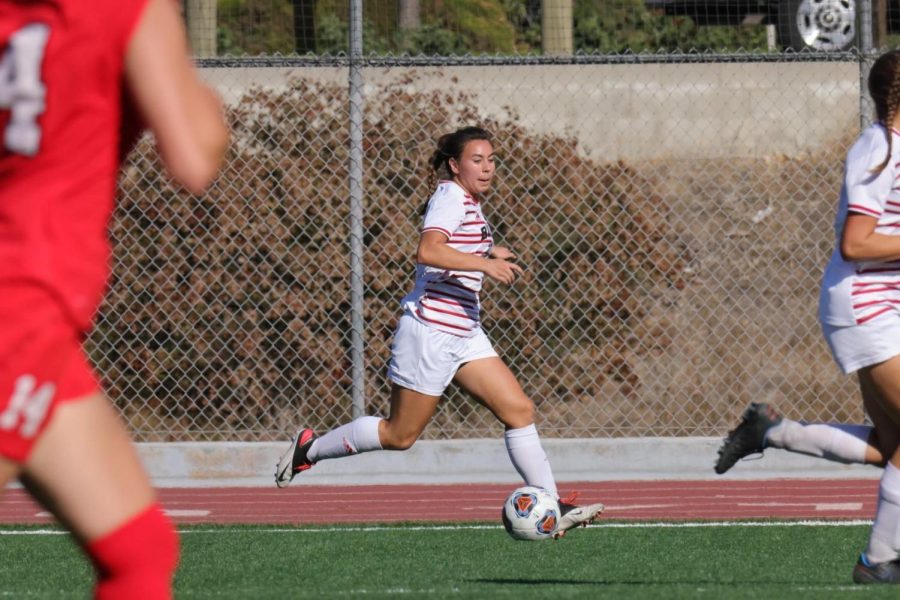
Student Missionary Union president Roddy Garcia (left) and team development staff member Garrett Brooks (right) sit down to share SMU’s vision for 2013. Garcia is pushing his 28-person staff to focus on local missions this year. | Natalie Lockard/THE CHIMES
90 years after Biola’s Student Missionary Union began as a student-run missional outreach organization, current senior and SMU president, Roddy Garcia, anticipates embracing the rich history of SMU and engaging students in current and local missions this year.
Garcia, a psychology major, greeted me with a huge smile and firm handshake. He then sat me down in his comfortable and rather cozy office tucked away inside the Upper SUB.
Jackie Grade: What is your vision for SMU, and how do you want that to play out?
Roddy Garcia: It’s our 90th year. We started back in 1923. There has been a lot of history within the local [community]. But then, over the past 15 years or so, our focus definitely became more on Missions Conference — which I think is the 85th year — and also our short term missions trips. We had a pretty strong presence in the city, but somewhere along the way that was lost. What we want to do this year … is restore some of that old history but also acknowledge … the way the world is shifting.
JG: What are three specific goals SMU plans to accomplish by the end of the year?
RG: The SMU staff has come up with first to have an Acts 1:8 model of missions. You are not necessarily driving 30 minutes to get to LAX only to get on a plane to go out and reach the nations. The nations are in the city. We really want to get people to understand that you do not have to go over a sea of saltwater to participate in the great commission. Let’s do it here. Let’s focus on unreached people groups. But, there are people here who need to hear the gospel too.
That ties in with next point … which is much more of “everyone’s everywhere.” We are told to preach the gospel to the ends of the earth. The church in Africa has the same command. Our ends of the earth is Africa, or China or something like that. But where do they go? We are coming to find out that there is a huge presence of the global church and global Christians in this country. How are we to engage … or partner with them?
The third would be the validation of the roles of all believers in the completion of the great commission. Basically, we all have a part by virtue of being a Christian. The famous SMU scripture that we toss around a lot is Matthew 28:19 — about the great commission. When Jesus says “Go, therefore, and make disciples,” the word “go” there literally means “along the way…” and doesn’t mean just geography, per se. It is a lifestyle thing. It’s not just being a missionary. It’s people who are traditionally seen more in the secular field and [re-validating] their role in the making of disciples.
JG: How do you plan on emphasizing local missions?
RG: We are navigating what that looks like. We operate through Biola and function very much as a parachurch organization. We want to seek out opportunities where we can help the local church and lead students to the local church by getting them engaged. We don’t want to take students away from the local church. Rather than starting initiatives on our own, we want to work with the church and engage them in a community at their church.
JG: What are the biggest changes in SMU from last year?
RG: The short-term missions rotates every year depending on where the student leaders’ interests lie. This creates a lot of passion because the student leaders are able to pick where they want to go and what exactly they want to do. But as far as for the health of those trips, we are only partnering with people for a time. It can be harmful. So we are looking into more longer term partnerships and cultivating relationships with churches in a global context. Logistically, it is easier when you have the precedence to do a trip. Relationally, you've established those relationship channels. And even the community — the trips that have gone in years past — sharing that wisdom and passing it on just makes it an overall better experience.
JG: What kind of missions trips do you have planned?
RG: We send our trips over interterm and over the summer. Last summer, we sent out trips to India, Greece, Nepal, China, Mongolia and Central Asia. The summer trips are longer and typically anywhere from five to eight weeks. We also just finalized our [2013] interterm trips today.
JG: What is the biggest thing you look forward to this year?
RG: I think that hopefully through the staff development that we are doing, integrative trips which are major-specific and just more intentionally reaching out to the Biola community, students who may not have thought missions [were] for them and maybe dismissed the role that they play in discipleship will be validated. They will be able to find worth in missions … and contribute to the missional goal as a whole.
Just outside Garcia’s office sat senior Garrett Brooks. The team development staff member’s eyes lit up as he dove into the logistics of his summer missions trip. As a co-leader for the six-week Mongolia trip this past summer, Brooks mentored students while simultaneously experiencing his first mission trip.
JG: What role do you play in SMU?
Garrett Brooks: My title is team development. There’s three of us, I am one of the three, and we help mentor the team leaders that are going out on the trip. There is a class that they have to take during the semester and we teach the second half of the class as well.
JG: What is one thing that stuck out to you as a leader on the Mongolia trip?
GB: I think how interesting it is pulling people from different majors and from different parts of campus and kind of seeing how they blend together and how we can unite as team. Because … I didn’t know my co-leader at first. I only knew one person on the team. And so, it was just building relationships from the bottom and kind of trying to nurture those relationships because we are going to be in the same country for six weeks together.
JG: How did it go exactly?
GB: It went surprisingly well. We were all very different. We were anxious to see how it would work out, but it was actually a really solid group. There was, surprisingly, no problems on the trip. I think a lot of people expect that there’s going to be problems. But, we went thinking, “we will get along,” and it went really well.
JG: How have you seen SMU change since last semester?
GB: I think right now it’s just ideas of how we are going to change it because it has been so new. It has been just a few weeks. But, I think [there is] an intentionality of everyone to make a change and try and reach out more to [students].







